The Leibstandarte returned to the Eastern Front in January 1943 as part of the newly created SS Panzer Corps, along with its sister divisions 2. SS Panzerdivision Das Reich and 3. SS Panzerdivision Totenkopf. The constituent units of this new SS Panzer Corps would be distributed at various key points on the front, with the Leibstandarte and much of Das Reich being relocated in the areas around the cities of Khar’kov and Byelgorod in the Eastern Ukraine.
Michael Wittmann, now assigned to the 4th schwere (heavy) Company of the 1st SS Regiment Leibstandarte SS Adolf Hitler, was to return to a Russian front far different from that he had left behind in the summer of 1942: the Soviets were more organised and far less reckless in their approach, and the German Army were a far cry from the fresh and well-oiled war machine that had enthusiastically stormed across the Steppes eighteen months previously.
Having overcome the initial onslaught at the end of 1941 and the first half of 1942, the Red Army had gradually started to turn the tables on the German forces. Fresh back at the front, Wittmann and his comrades were thrown headlong into the struggle and quickly found themselves on the back foot.
Return to the Front
On returning to unit training on Christmas Eve 1942, Wittmann was not immediately given the command of a Tiger; instead, he was assigned the role of commander of 4th Company’s light platoon, which consisted of five Panzer III Ausf. Js – nimble, reliable and robust machines, if a little dated. The role of the light platoon was a defensive one. Faster and more agile than the considerably heavier Tiger, the objective of the Panzer III was to provide a highly mobile screen, keeping close range threats at bay with its 50mm KwK gun.
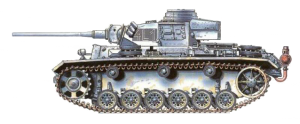
Unlike previous versions of the Panzer III that had proved itself in earlier battles, the newer Ausf. J was equipped with additional bow and turret armour. Wittmann’s designated machine as platoon commander was Nr. 4L1, and his squad consisted of SS-Oberscharführer Max Merten, SS-Scharführer Georg Lötszch, SS-Unterscharführer Schwerin and a nineteen year old Austrian, SS-Rottenführer Franz Staudegger. The latter in particular proved to be a precocious talent, and like the older Wittmann would later go on to become an ace in his own right.
In addition to the five Panzer IIIs of the light platoon, 4th Company was equipped with fifteen Tiger Is, divided into three platoons of four as well a command vehicle, company HQ vehicle and reserve vehicle. The company commander was SS-Hauptsturmführer Heinrich (Heinz) Kling, who had been transferred to the Leibstandarte from the SS-Totenkopfstandarte in 1940.
Within just two months of the arrival of Wittmann and his crew in Russia, the Wehrmacht’s Sixth Army had suffered the shattering defeat at Stalingrad. The tide had long since turned against the Germans, but Stalingrad was a hammer blow with close to a quarter of a million men killed or captured. Contrary to the propaganda newsreels being aired in Berlin, the Russian bear was far from dead. The Red Army held the upper hand, and German forces simply had to dig in, defend and regroup.
As the battlefield casualties mounted, the severe entry standards for both the LSSAH and the Waffen-SS as a whole were gradually relaxed. Thousands of volunteers from all over Europe, ever more fearful of the dreaded Red scourge working its way westward, would throw in their lot with the Germans. Large numbers of young men took the opportunity to join the ranks of the Waffen-SS, and many would serve with distinction.
By mid-March of 1943 the Ukrainian city of Khar’kov had been recaptured by the Leibstandarte, but this was a rare positive in what had turned into a desperate mission to stem the relentless enemy advance. While thousands of men and armoured vehicles were being churned out by the Soviets from what appeared to be nowhere, the Germans were finding it increasingly difficult to make good the losses suffered by their highly professional forces, which up to now had managing to hold their own in spite of being terribly outnumbered in the field – often by as much as ten to one.
Nevertheless, there was good reason for optimism as the men of the Leibstandarte moved into their new quarters on the outskirts of the recaptured city, moving in with members of the local Ukrainian population.
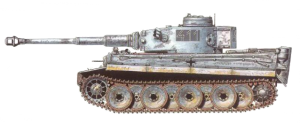
Tiger Commander
Following the arrival at the front of five new Tigers at the beginning of April 1943, SS-Untersturmführer Michael Wittmann was finally given one of his own. Assigned to the command of this new third platoon, Wittmann took ownership of turret number 411. Wittmann was joined by SS-Oberscharführer Max Merten and SS-Unterscharführers Hans Höld, Jürgen Brandt and Kurt Sowa.
The expanded 4th Company now consisted of twenty-two vehicles: seventeen Tigers (three platoons of five and the two command vehicles) and the five Panzer IIIs that comprised the light platoon. At the end of April and beginning of May, the new crews were put through their paces; these training routines were organised by both Wittmann and his good friend SS-Untersturmführer Helmut “Bubi” Wendorff, who like Wittmann had also fought with distinction in the assault gun units both in the Balkans and the early stages of the Russian campaign prior to his being assigned to the Tiger company.
While placing a great deal of attention on tactics, the training was far from dull. Wittmann in particular would make a good impression on the new recruits; the twenty-nine year old Bavarian was by now a grizzled veteran who had been steeled by the heat of battle, but he still managed to retain his patient and calm demeanour.
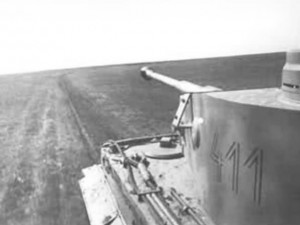
At the end of May, 4th Company was renamed to the 13th schwere (heavy) Company, reporting to SS-Hauptsturführer Kling. The prefix number 13 was painted on the turrets of all of 13th Company’s freshly-camouflaged vehicles; as commander of the third platoon, Michael Wittmann’s Tiger was designated number 1331 – 13 for the Company, 3 for the platoon, and the final 1 for the position of platoon commander.
As the conflict on the Eastern Front continued to drag on, the loss of quality personnel was acute – with little or no time to train suitable replacements. Although such men were at a premium, the very nature of the conflict always meant that the most experienced and battle-hardened were nearly always thrown into the fire first. Michael Wittmann was one of these “fire-fighters”, and answered all of the questions that were asked of him and his crew.
Wittmann’s next challenge was to involve him in what was to be the biggest tank battle of the Second World War, a battle that was to prove decisive in turning the tide once and for all against Germany.
Operation “Zitadelle” and the Battle of Kursk
The successful advance by the Germans and the retaking of Khar’kov had left a massive Soviet-held salient protruding into the front line, with the key areas surrounding the southern city of Kursk. The aim of “Zitadelle” (Citadel) was to pinch and squeeze off this pocket by attacking from both the north and the south, uniting Army Groups Centre and South to seal up the front line.
In what was effectively akin to a game of tactical poker, all of the chips were on the table and the Germans were going all in.
The men and machines of the Leibstandarte, along with those of its sister Waffen-SS divisions Das Reich and Totenkopf, would make up the II SS Panzerkorps under the command of SS-Obergruppenführer Paul “Papa” Hausser, assigned to Generaloberst Hermann Hoth’s 4th Panzer Army – part of Generalfeldmarschall Erich von Manstein’s Army Group South (Heeresgruppe Süd). The 4th Panzer Army would be part of the southern part of the “pincer”, tasked with advancing northwards before heading east towards Kursk itself.
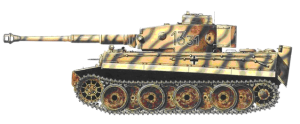
Thousands of men and machines, supported by the Luftwaffe providing air support, were organised for this massive undertaking, and it was sure to many at this point that failure would mean almost certain annihilation. II SS Panzerkorps supplied just under five-hundred tanks and armoured vehicles for what would turn into the greatest armoured battle in history.
The first day of the attack – X-Day, 5th July 1943 – saw the eleven serviceable Tigers under SS-Hauptsturmführer Kling move northwards from their starting point close to the town of Bykovka, under instructions to break through the Soviet defences located to the south and south-east of the town. The enemy forces, which consisted of flame-throwers, anti-tank guns and T34 tanks, were well organised; during this first skirmish, Wittmann’s Tiger quickly took out two of the T34s. With the other Tigers destroying the anti-tank guns and a number of the enemy T34s, the remaining enemy vehicles quickly retreated as the LSSAH advanced into Bykovka.
It was to be a dramatic day for Wittmann and his crew; during the many sorties that were undertaken, loader Walter Koch was hit in the head with splinters and the Tiger drove over a mine, damaging one of the tracks. The injured Koch was replaced by SS-Panzerschütze Max Gaube, and the Tiger was quickly towed away to safety. In spite of the small misfortunes that came its way, Wittmann’s Tiger had destroyed fifteen pieces of enemy materiel, eight Panzers and seven of the much-feared anti-tank guns.
Although the injuries suffered by Wittmann’s crew during the first day were not to be repeated, they would face a desperate struggle to keep their battered machine running. For the next four days, Wittmann and his crew – gunner Bobby Woll, driver Siegfried Fuss, loader Max Gaube and radio operator Karl Lieber – found themselves working overtime. The back-to-back combat sorties were relentless, with the exception of 9th July when a number of Panzer crews, including Wittmann’s, were provided with what was a well-earned rest in the city of Teterevino. Following the injuries sustained to Heinz Kling and then his stand-in SS-Obersturmführer Waldemar Schütz, Wittmann would take over as acting company commander on 11th July.
The battle had been intense, and had left the twenty-nine year old Panzer ace utterly exhausted. By this time, his Tiger had destroyed some thirty enemy tanks and twenty-eight anti-tank guns. During this period, heroic actions were being performed by a number of Wittmann’s colleagues, not least the twenty year old SS-Unterscharführer Franz Staudegger, now part of Helmut Wendorff’s second platoon, who on 7th July destroyed an astonishing twenty-two enemy T34s in a single action – a feat that would earn the young Austrian the coveted Knight’s Cross.
The Battle of Prokhorovka
The Leibstandarte was the more successful of the three Waffen-SS divisions during the advance. After making their way through the Psel river corridor and staving off repeated assaults from the enemy, Michael Wittmann and his colleagues were just three kilometres from the small and hitherto insignificant town of Prokhorovka.
On the morning of 12th July, the scene had been set for what would be the biggest single tank battle in history – and perhaps the most decisive moment of the war – as more than two-thousand armoured vehicles and anti-tank guns from both sides converged on a large plain south of Kursk in the vicinity of Prokhorovka. Some ninety kilometres south-east of Kursk the II SS Panzerkorps – a force of just under three-hundred vehicles including fifteen Tiger Is – squared up to the 5th Guards Tank Army of the Red Army, with the battlefield area spanning some twenty kilometres.
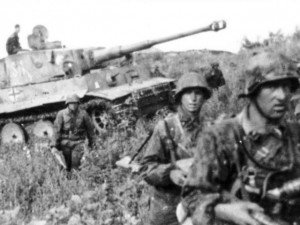
Despite being outnumbered by more than three vehicles to one, the Waffen-SS divisions more than held their own, standing firm in the face of wave after wave of Soviet attacks. Totenkopf would take the northern route and Das Reich the south, while the Leibstandarte were tasked with engaging the enemy directly in advancing towards the settlement.
Unknown to II Panzerkorps commander Hausser, two fresh Soviet formations – the 18th and 29th Tank Corps of Lieutenant-General Pavel Rotmistrov’s 5th Guards Tank Army – had positioned themselves south of the town for its own counterattack. The extent of Rotmistrov’s counterattack would initially take the Leibstandarte by surprise, but after the initial shock the advanced units had recovered sufficiently to hold their positions.
The Leibstandarte would have just under a hundred tanks at its disposal, most of which were Panzer IVs and older and lightly-armoured Panzer IIIs. They had only four fully serviceable Tigers – including that of Michael Wittmann – but did not lose any ground during a battle that had seen them successfully repel the enemy formations. The anti-tank ditches had proved to be effective in nullifying the enemy threat, and Luftwaffe support had also been crucial in disrupting and repelling the fast-advancing Soviet armour.
The Leibstandarte hold firm
After a day of intense fighting, the area around what had been designated Hill 252.2 was held by the LSSAH forces. The other two Waffen-SS divisions meanwhile experienced mixed fortunes: Totenkopf had sustained heavy casualties in reaching its intended assembly point north-west of Prokhorovka, and Das Reich found themselves bogged down in the face of fierce Soviet resistance. As the battle raged, the dry, flat Steppeland soon became a picture of destruction, littered with the burning carcasses of hundreds of armoured vehicles and the twisted and charred bodies of dead crews and infantrymen.
When the figures were totted up at the end of the day, it would look like a staggering victory for the German formations. Only a handful of tanks had been lost, compared to the figures for the Soviets that ran into the hundreds. Reports concerning the losses on both sides have varied and have themselves created plenty of discussion, but nearly all of the available sources agree that the Leibstandarte would only see one Tiger put out of commission, and even that was recoverable and repairable. According to the historian Christer Bergström, the Germans had lost 850 men and a total of just five Panzers during the battle, compared to Soviet losses of 5,500 men killed or wounded and three hundred tanks.(1)
The battle would ultimately be decided in the end by sheer weight of numbers. The smaller German formations, in spite of the skill and professionalism of their crews, found themselves being overwhelmed by wave after wave of Soviet T34/76s and KV Is. While the German machines were at a premium, the destruction of one Soviet tank just seemed to spawn the arrival of two more.
While the Soviets were able to overcome the profligate tactics employed by 5th Guards Tank Army commander Rotmistrov and absorb their heavy loses, the impact on the threadbare Waffen-SS divisions ensured that the planned German advance would came to a juddering halt.
The Battle of Prokhorovka had been a tactical victory, but not an operational one. Stalin’s propaganda agencies meanwhile went into overdrive, citing the destruction of large numbers of clearly fictitious Tiger tanks.
Although Michael Wittmann and his colleagues (the resting Bobby Woll had made way for SS-Unterscharführer Hermann Gräser) had been hugely successful in achieving their own particular objectives, the overall situation was bleak – something that even the optimistic Hitler would finally acknowledge.
As the battle headed towards its inevitable conclusion, the Leibstandarte’s Tiger company continued to serve with both distinction and élan. On 14th July, it had only five serviceable machines, a figure that had improved to nine by 17th July, which saw Wittmann and his colleagues retreat to a position west of the city of Byelgorod. Many men had been lost, and despite the successes of the Tiger company and the LSSAH as a whole, Kursk still remained in the hands of the Soviets. Quite simply, the German forces had been overwhelmed by the sheer numerical strength of their opponents. The key battle around Prokhorovka may have been won, but the plan to close off the Kursk salient, Operation “Zitadelle”, had failed.
By the afternoon of July 17th the order was given for the withdrawal of II SS Panzercorps, which saw Michael Wittmann and his comrades redeployed to Italy.
Rest, refit and reformation
Setting out from the Eastern Front at the end of July 1943, Wittmann and the Tiger Company arrived in southern Italy during the first week of the following month, settling into their new quarters close to the town of Reggio on 8th August. To men who previously had found themselves baking in the heat of battle in the East, this was something close to paradise.
The Autumn of 1943 was to witness yet another formation change for the 13th Tiger company; a new Panzer battalion – the 101st – was formed, and the 13th (heavy) company was to be the basis of the third company of this new battalion. Commanding this new formation was SS-Hauptsturmführer Kling, who had returned to duty having been wounded during the Kursk offensive. A brand new batch of Tigers arrived, and the strength of the company was upped to twenty-seven vehicles: the command and HQ tanks and five platoons of five Tigers each. Michael Wittman was given command of the second platoon, whose other commanders included SS-Unterscharführers Ewald Mölly and Kurt Kleber, SS-Oberscharführer Jürgen Brandt and Hauptscharführer Hans Höflinger.
The reformation and expansion of the unit resulted in more personnel being drafted in; it also meant more of the same theory and practice for those who had been there and seen it all before. All of this was not without its lighter moments, however – particularly one comical story involving Michael Wittmann engaging on what turned out to be a tank-to-tank hunt for a stolen Parmesan cheese:
One group laid its hands on a locally-made cheese. The large round cheese was taken in a “night and fog” operation; it was cut up into more manageable portions with a bayonet and then divided up. Somehow or other word about this unauthorised supplement to the company’s rations got out and there was a huge flap. SS-Untersturmführer Wittmann crawled into every Tiger looking for cheese. Faced with the threat posed by Wittmann, the evil-doers used the opportunity to eat their hoarded portions. In most cases this was sufficient to satisfy the thieves’ appetite for parmesan cheese for some time.(2)
After undergoing in-tank cheese searches, bouts of diarrhoea following the over-consumption of local grapes (the eating of which was subsequently banned) and witnessing the surrender of the Italians to the Allies in early September, the Tiger company was once again readied for action, and a return to the Russian front. The Tigers were also given new turret designations – the number 13 being replaced by the letter “S” for schwere (heavy). As leader of the second platoon, Michael Wittmann’s Tiger was designated S21. On the front of each vehicle was the symbol of the Leibstandarte, the skeleton key or Dietrich, after the divisional commander, SS-Obergruppenführer Josef “Sepp” Dietrich.
At the beginning of November, the first tanks of the newly formed 13th Company – the core of the fledgling 101st Panzer Battalion – began to be transported towards the Eastern Front. On 11th November, the transport train carrying the powerful new 13th Tiger company would arrive at Berdichev in the Ukraine.
